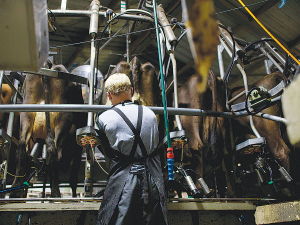2024/25 Dairy Statistics: NZ dairy farmers boost production with fewer cows
According to the New Zealand Dairy Statistics 2024/25 report, New Zealand dairy farmers are achieving more with fewer cows.
 One of the main reasons for a shift to flexible milking is to reduce hours, make rosters more flexible and improve work.
One of the main reasons for a shift to flexible milking is to reduce hours, make rosters more flexible and improve work.
With milkings typically taking around 17 to 24 hours a week per worker, many farmers have been focusing on milking smarter to reduce hours and creative ways to shorten the working week - like the 22% who report they are using flexible milking.
One of the milking reasons for a shift to flexible milking is to reduce hours, make rosters more flexible and improve work/life balance for their team.
For Taranaki farmers Daryl and Karyn Johnson, using 3 in 2 milking has seen their team's working week shortened by six hours each per week. Many farmers are also having success with a 10 in 7 milking schedule that maintains traditional morning and afternoon milking times but frees up a few afternoons each week.
Milking smarter has seen some operations introducing a maximum milking time (MaxT), which can reduce milking times without compromising production or udder health. Interestingly, leaving some milk behind in slow milking cows can increase the flow rate in the next milking, improving milking efficiency.
Fonterra suppliers recently received Insights reports showing their milking efficiency compared to similar operations, and how much time they could save by reaching 80-100% milking efficiency. The average possible saving at peak was 8 hours per week.
Align Farms in Mid-Canterbury allow their team to pick shifts, with the first pick rotating between staff, usually with the most popular shifts being morning and midday, leaving afternoons free.
Flexible rostering means the team control their working week, allowing them to pick shifts around other commitments and hobbies, while also allowing Align Farms to take on people looking for work opportunities, including part-time positions. They describe these workers as some of the smartest people, and the farm benefits from having a diverse and interesting workplace.
Reducing the hours your people work to 50 hours or less a week reduces stress, fatigue, and the risk of accidents, and helps you attract and keep good employees.
For more information visit www.dairynz.co.nz/milking
Seonaid Aitchison is DairyNZ solutions and development specialist.
The Government is set to announce two new acts to replace the contentious Resource Management Act (RMA) with the Prime Minister hinting that consents required by farmers could reduce by 46%.
Prime Minister Christopher Luxon says withdrawing from the Paris Agreement on climate change would be “a really dumb move”.
The University of Waikato has broken ground on its new medical school building.
Undoubtedly the doyen of rural culture, always with a wry smile, our favourite ginger ninja, Te Radar, in conjunction with his wife Ruth Spencer, has recently released an enchanting, yet educational read centred around rural New Zealand in one hundred objects.
Farmers are being urged to keep on top of measures to control Cysticerus ovis - or sheep measles - following a spike in infection rates.
The avocado industry is facing an extremely challenging season with all parts of the supply chain, especially growers, being warned to prepare for any eventuality.